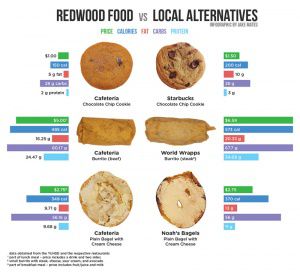With several new federal regulations that have been imposed in the past two years, and the prospect of even more regulations to come, the Tam District’s Student Nutrition Services is grappling with providing a healthy cafeteria menu for students while still keeping costs affordable.
Henry London, the new director of Student Nutrition Services, said that the food services department, which serves the whole district, has been faced with recent legislation that has placed stringent nutritional guidelines on lunch and breakfast items, and will face even more restrictions on the á la carte menu next fall.
The implementation of new sodium targets and the Senate bill dubbed “Smart Snacks in Schools” will bring major changes to the current snacks that are offered both in the cafeteria and in vending machines, and Student Nutrition Services will likely be forced to discontinue many of the current á la carte items. They will also be forced to remove Gatorade, which violates the standard for beverages that states that beverages must be 40 calories or less per eight ounce serving, unless the manufacturer changes the product to meet the guidelines.

Major changes have been made this year to the breakfast menu, including an increase in price from $2.50 to $2.75, and that students are now required to take one cup of fruit and a juice with their breakfast meal. Previously, students were only required to take either milk, fruit, or juice.
London brought changes of his own that include providing pre-baked cookies from a new vendor instead of the ones last year that were baked in the kitchen. Additionally, bagels are no longer provided at lunch.
Although many of the items last year were whole grain, this year’s federal regulations require that all items be whole grain. Currently, the only item that is out of compliance is the bagel, which the Student Nutrition Services is currently looking for a replacement for.
“We have to find new suppliers that offer á la carte products that meet the requirements,” London said.
However, according to London, finding vendors that offer low prices is no easy feat. He said that cost and whether students are willing to pay for the product pose the biggest challenges.
Even with the Student Nutrition Services’ efforts to find products with reasonable prices, some students are still unhappy with the price.
“The price is unreasonable,” junior Melissa Papuc said. “They force me to pay $3 for fruit and juice that I don’t want. All I want is the bagel.”
However, some students don’t mind the current prices. Freshman Kyle Smith said he thinks the food is worth the cost because of the taste and the quantity he receives.
Junior Brianna Frierson also thought that the food was worth the price.
“I think it’s reasonable because you can also get vegetables, fruit, and juice,” she said.
Although the “healthiness” of the food doesn’t factor into what he orders, junior Devon Thomas said he thinks that overall, the food is pretty nutritious, but overpriced.
“The bagels are good–I would rather eat here than spend more money off campus,” Thomas said. “It should be better quality for the five dollars, though.”
Some students think that the changes have decreased the quality and taste of some of the items in the menu.
“It tastes like cardboard now since they tried to make it healthier,” senior Arianna Mahallati said.
In order to address student concerns such as these, Student Nutrition Services has been surveying students for feedback.
“We will continue to do [surveys] to give feedback to us to better enhance our program,” London said. “Our goal is to build student participation at all school sites.”
Despite some complaints, the number of student purchases of meals has increased, according to Becki Lamet, the manager of the Redwood Café. Although it varies each day, the cafeteria serves nearly 200 breakfasts and 250 to 300 lunches per day.
The legislation that brought major these changes to the school lunch program was the Healthy Hunger Free the Kids Act, passed by Congress in 2010, which requires all school districts in the state of California to meet certain standards for breakfast and lunch items. The law went into effect July 1, 2012 for lunch items, and July 1, 2013 for breakfast items.
Under this act, the school district is required to provide five main components on their menu: meats and meat alternatives, 50 percent enriched whole grains, milks, fruits, and vegetables.
Each individual menu item also undergoes a nutritional analysis for calories, saturated fats, sodium targets, grams, and trans fat, and is required meals to be within 750 to 850 calories.
New sodium targets that go into effect July 1, 2014 will also place even more rigorous restrictions on lunch and breakfast items, requiring all items to be less than 740 grams of sodium.
Additionally, “Smart Snacks in Schools” will also go into effect in 2014, and will require that all á la carte items, which include items sold in vending machines, meet the nutritional guidelines for fat, saturated fats, trans fats, sugars, calories, and sodium.






